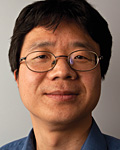Biological 3D Structures by Cryo-EM: Challenges in Computations and Instruments
Category
Published on
Abstract
Single particle cryo-EM is revolutionizing structural biology. Many structures of viruses and protein complexes have been determined to 2-4 Å resolutions. While stable structures that can be expressed/purified in large quantities can be solved routinely, the dynamic compositions and conformations of many protein complexes pose serious challenges to current image processing/3D reconstruction algorithms and computing resources. Novel algorithms or computational methods will be needed to overcome these challenges.
While single particle cryo-EM solve the in vitro structures using isolated protein complexes, high resolution in situ structures in the context of cells using electron tomography are the ultimate goal of structural biology. Due to the limited penetration power of current TEMs at 300 kV, the cells are too thick and must be sectioned into thin slices before being imaged with a TEM. Direct imaging of whole cells will require MeV TEM instruments which are too expensive and inaccessible. Novel design of compact TEMs might make it possible to directly image whole cells.
Bio
 Dr. Jiang’s primary appointment is a Professor in the Department of Biological Sciences at Purdue University. He is also the scientific director of the Purdue Cryo-EM Facility. In addition, he has a courtesy appointment in the Department of Chemistry, Purdue University and is a member of the Purdue Center for Cancer Research, Purdue Institute for Drug Discovery, Purdue Institute of Inflammation, Immunology and Infectious Disease (PI4D).
Dr. Jiang’s primary appointment is a Professor in the Department of Biological Sciences at Purdue University. He is also the scientific director of the Purdue Cryo-EM Facility. In addition, he has a courtesy appointment in the Department of Chemistry, Purdue University and is a member of the Purdue Center for Cancer Research, Purdue Institute for Drug Discovery, Purdue Institute of Inflammation, Immunology and Infectious Disease (PI4D).
Dr. Jiang received his B.S. degree in Physics from Peking University, M.S. in Biophysics from the Institute of Biophysics, Chinese Academy and Sciences, and Ph.D./Postdoc in Cryo-EM with Prof. Wah Chiu from Baylor College of Medicine
His group's research interests are in structural biology of viruses, large macromolecular complexes, and membrane proteins. The major tool we use is electron cryo-microscopy (cryo-EM), an emerging technique that has seen dramatic progresses and expansion of the field recently. Our research centers around technique development and application of this method, aiming at higher resolution (2-4 Angstrom), higher throughput imaging and 3-D reconstruction, and broader applicability for new target systems and by novice users.
Sponsored by
Cite this work
Researchers should cite this work as follows:
Time
Location
Burton Morgan, Room 129, Purdue University, West Lafayette, IN